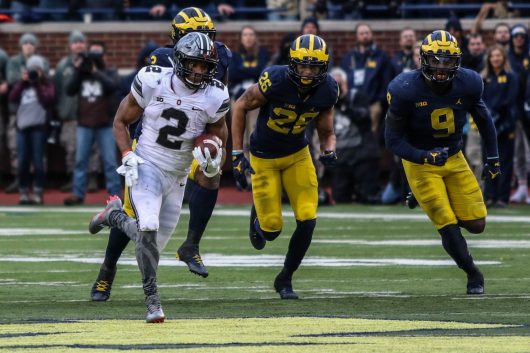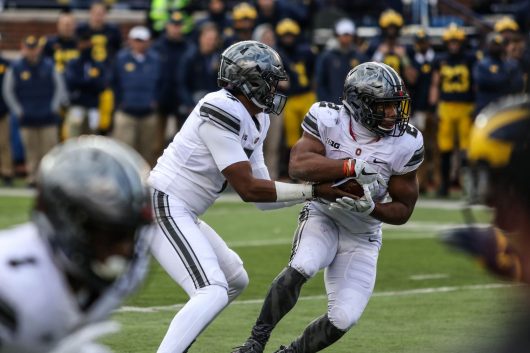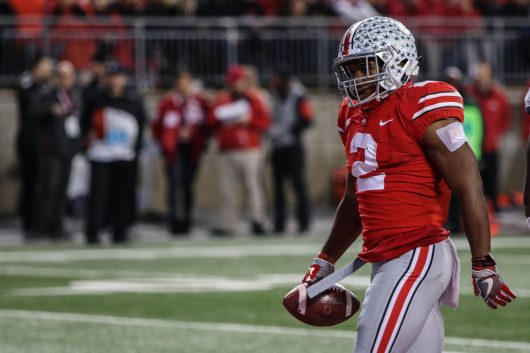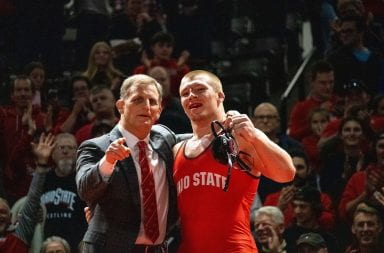
Ohio State freshman running back J.K. Dobbins (2) runs the ball in the third quarter of the game against Michigan on Nov. 25 in Ann Arbor. Ohio State won 31-20. Credit: Jack Westerheide | Photo Editor
No freshman running back has led the Big Ten in rushing yards in over a decade. Wisconsin then-freshman P.J. Hill racked up 1,569 yards in 2006, but every leading rusher since him has been a sophomore or upperclassman.
This year, that will change. Badger true freshman running back Jonathan Taylor leads the conference with 1,806 rush yards. Sitting in second place, more than 600 yards behind Wisconsin’s phenom, is Ohio State true freshman running back J.K. Dobbins. Dobbins has 1,190 yards, more than the 1,096 yards last year’s starter, Mike Weber, had as a redshirt freshman.
In the Big Ten championship game Saturday, they will face off in the first of many possible battles between the present and future of the conference’s best running backs. In the Big Ten, a storied conference loaded with run-first teams and former highly ranked running back recruits, physically mature veterans nearly always lead in rushing.
Ohio State co-offensive coordinator Kevin Wilson, who worked as Oklahoma’s offensive coordinator in 2004 when then-freshman running back Adrian Peterson rushed for 1,925 yards, attributed the success to freshmen entering programs as “young men,” not “little kids.”

Ohio State redshirt freshman quarterback Dwayne Haskins (7) hands the ball off to freshman running back J.K. Dobbins (2) in the third quarter of the game against Michigan on Nov. 25 in Ann Arbor. Ohio State won 31-20. Credit: Jack Westerheide | Photo Editor
“One, it’s raw talent, but is the kid mature enough to handle the protections and the thought process because there’s some communication where there’s some guys who have the skill-set and they can’t process mentally,” Wilson said Tuesday evening.
Dobbins and Taylor are the anomaly. That’s what makes their matchup on Saturday so intriguing. Many believe in the “freshman wall,” a name given to something freshmen who are not used to playing an extended schedule against collegiate competition.
When asked about whether he hit the proverbial wall, Dobbins scoffed.
“I don’t feel like I’ve hit that wall, I don’t feel like I did,” he said almost incredulously.
The proof of his confidence is seen in the numbers. In his first collegiate game, Dobbins picked up 181 yards on 29 carries, an average of 6.2 yards per rush. The next game, against Oklahoma, he added 13 rushes for 72 yards, averaging 5.5 yards per carry. Since then, he has rushed for less than 6.7 yards per carry just once, when he picked up 4.3 yards per carry two weeks ago against Illinois.
Wilson said he has been conscious of the freshman’s carry count, spelling him in games and in practice with Weber, who became the third freshman in program history to rush for more than 1,000 yards last season, and sophomore Antonio Williams.
“You’ve got to be able to practice hard enough to get them tough, but you can’t over-practice, you can’t burn them out,” Wilson said. “You’ve got to be smart with them.”
The return of Weber, who had just seven carries in the first four games due to an injury, takes pressure off Dobbins to be the Buckeyes’ bell cow running back. Weber has even received double-digit carries in each of the past two games.
Unlike Dobbins, Taylor has been pushed to the maximum without anyone to sub in for him in most games. Wisconsin’s second-leading rusher, running back Bradrick Shaw, has 96 carries, more than 150 fewer than Taylor. And Shaw has not been nearly as successful as Weber, who has a 6.5 yard per carry average. Shaw averages just 3.7 yards per carry.

Ohio State freshman running back J.K. Dobbins (2) runs the ball in for a touchdown in the first half in the game against Illinois on Nov. 18. Ohio State won 52-14. Credit: Jack Westerheide | Photo Editor
But Taylor has continued his stretch of dominance, averaging at least 5.4 yards per carry in each of the past eight games. He has received less than 19 carries just once during the stretch.
On a teleconference Monday, redshirt linebacker Chris Worley said Taylor “doesn’t run like a freshman.” It did not take long for him and the rest of Ohio State’s first-team defense to learn the same about Dobbins.
During spring practice, the first-team offense was working on getting out of its end zone against the Buckeyes’ starting defense. The coaches put the offense on its own 1-yard line.
Redshirt senior quarterback J.T. Barrett took a snap and handed the ball to Dobbins, who took just seconds to leave all the first-team defenders in the dust.
“He busted up a 99-yard touchdown run, and that’s when I was like, ‘Oh, this is going to be for real,’” senior left tackle Jamarco Jones said. “He’s for real.”
Dobbins knows he’s for real.
When asked whether the college game has been easier than he anticipated, he smirked, chuckled and said, “Yeah.” Dobbins said he thought it would be more difficult both physically and mentally.
Even still, he was confident he would be OK.
“I thought it was going to be really hard, but I knew I was going to do good,” Dobbins said. “I didn’t know it was going to be like this.”
On Saturday on the conference’s biggest stage, Dobbins and Taylor will have the opportunity to not just prove who the Big Ten’s future greatest running back will be, but who is already the best.


